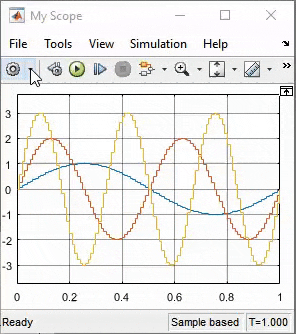

The first subplot is in the top left corner, The subplots are arranged in the same manner as you would read a book. We could have easily made another plot using the subplot(2,2,4) command. You do not have to fill all of the subplots you have created, but MATLAB will leave a spot for every position in the matrix.
Matlab simulink plot code#
The following code will accomplish this.Īs you can see, there are only three plots, even though we created a 2 x 2 matrix of 4 subplots. Wave plotted on the same figure, but not on the same axes.


For instance, suppose you want to see a sine wave, cosine wave, and tangent The p'th plot is selected as the currently active plot. This command splits the figure into a matrix of m rows and n columns, thereby creating m*n plots on one figure. The following line of code is entered into the MATLAB command window or run from an m-file. The subplot command allows you to separate the figure into as many plots as desired, and put them all in one figure. More than one plot can be put in the same figure on its own set of axes using the subplot command. The same plot shown above could be generated using the following code.Īlways remember that if you use the hold on command all plots from then on will be generated on one set of axes without erasing the previous plot until the hold off command is issued. Is useful to differentiate the different data sets based on color and point marker. When plotting many things on the same graph it
Matlab simulink plot series#
With the sine wave as a solid red line and the cosine wave as a series of green x's.īy adding more sets of parameters to plot, you can plot as many different data sets on the same figure as you want. The following m-file will plot a sine wave and cosine wave, Same set of axes, using a different color and style for each. Let's say you want to plot a sine wave and cosine wave on the You can also plot more than one function on the same figure. Of colors, point markers, and line styles are summarized below. The third input consists of one to three characters which specify a color, point marker type, and/or line style. For example, to plot the above function as a red, dotted line, change the m-file as follows to generate the figure The color, point marker, and line style can be changed on a plot by adding a third parameter (in single quotes) to the plot command. (on the horizontal axis) versus the imaginary part (on the vertical axis). If the input vector contains complex numbers, MATLAB plots the real part of each element Vector will be used for the horizontal axis). In that case the vector columns are plotted versus their indices (the The plot command can also be used with just one input vector. MATLAB can plot a 1 x n vector versus an n x 1 vector, or a 1 x n vector versus a 2 x n matrix (you will generate two lines), as long as n is the same for both vectors.

One thing to keep in mind when using the plot command is that the vectors x and y must be the same length. If we wished to plot this function, we could create an m-file with the following code to generate the basic plot shown below. Consider the following simple, linear function.
Matlab simulink plot how to#
The default is that each time the plot command is issued, the current figure willīe erased we will discuss how to override this below. This command will plot the elements of vector y (on the vertical axis of a figure) versus the elements of the vector x (on the horizontal axis of the figure). This code can be entered in the MATLAB command window or run from an m-file. The basic syntax of the function call is shownīelow. The plot command also happens to be one of the easiest functions to learn how to use. One of the most important functions in MATLAB is the plot function.


 0 kommentar(er)
0 kommentar(er)
